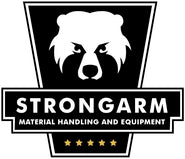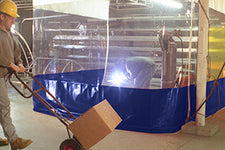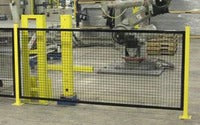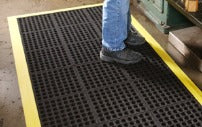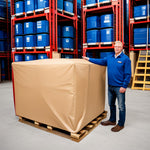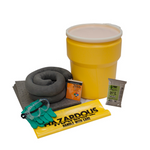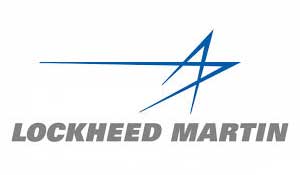Booth welding curtains act as safety barriers against UV radiation, metal spatter, and sparks released during welding activities. Businesses belonging to construction, metal fabrication, manufacturing, renewable energy, vocational training, and other industries routinely use booth welding curtains to safeguard their workers from dangerous flames and fumes.
Since booth welding curtains are an asset to any business where on-site welding is required, it’s crucial to clean and maintain them to ensure their longevity. Intact and clean booth welding curtains also ensure that your industrial facility complies with OSHA’s welding safety standards and saves business costs (by reducing the need for quick replacements). On the other hand, neglecting their upkeep might decrease their flame-resistant properties. This can further lead to an increased risk of fire.
Cleaning and maintaining booth welding curtains involves a step-by-step procedure:
Step 1: Know the type and style of booth welding curtains
Before even starting the cleaning process, it’s important to stay informed about the welding curtain styles:
§ Fixed welding curtains
§ Retractable welding curtains
The cleaning steps for retractable welding curtains differ from those for fixed welding curtains. Here’s the main difference: retractable welding curtains require additional cleaning because they contain tracks, rollers, and other moving parts. These components also need specific lubrication.
If you have tinted or opaque welding curtains, you should use soft cleaning materials (as harsh cleaners might fade the curtains). However, using strong cleaners for those made with vinyl-coated polyester isn’t a problem as they are chemical-resistant and more durable.
Step 2: Clean according to specific cleaning procedures
It’s important to learn about both cleaning procedures to avoid any mistakes. Let’s dig deeper into these below:
How to clean fixed welding curtains
Since you don’t have to move a fixed booth welding curtain, cleaning mainly focuses on its structure and surface. To clean a fixed welding curtain, you’ll need a mild cleaner or soap, a soft sponge, two pieces of dry cloth, warm water, a spray bottle (or bucket), inspection gloves, towels, and a ladder (in case the curtains are mounted high).
Here’s how to clean fixed booth welding curtains:
i. Stop all welding activities and switch off the nearby equipment. This will ensure that the welding curtains are safe to clean.
ii. Wipe the welding curtain with a dry cloth to remove loose debris, contaminants, surface dust, and metal particles.
iii. Prepare a cleaning mixture by mixing mild soap and water.
iv. Wet a piece of cloth with the soap-and-water mixture and gently rub the curtain. Start wiping from the top, and then, wipe in the downward direction. While wiping the curtain, focus on visible grime and weld spatter.
v. Now, rinse the welding curtain with another damp (and clean) cloth. This will help remove any soap residue. Once done, allow the curtain to air dry. You can also use a dry cloth to make sure it’s fully dry.
NOTE: Resume welding operations only after double-checking that the cleaned welding curtain has completely dried up.
How to clean retractable welding curtains
What makes retractable welding curtains unique is that these specialized curtains are made with moving components that can roll, fold, and slide. Cleaning these components involves excessive care and precision so they can function effectively without any debris. You’ll need the same materials (as those used for cleaning fixed welding curtains). In addition, you’ll also need a brush with soft bristles and a lubricant (if suggested by the manufacturer).
Cleaning retractable welding curtains requires the following steps:
i. Extend the welding curtain and ensure that it’s locked. This will help in achieving stability.
ii. Observe if dust has accumulated within the seams and folds. If there’s dust, gently brush these areas.
iii. Start cleaning the surface of the welding curtain with a sponge filled with the soap-and-water mixture. You need to avoid drenching. This might damage the track hardware and the rollers. Also, dry the surface immediately to make sure that the folded areas do not come in contact with moisture buildup.
iv. Use a brush to remove any metal particles or welding dust from the track and roller.
v. Some manufacturers recommend lubricating the rolling mechanism or sliding to avoid dust buildup. Check the manufacturer’s instructions and use a reliable lubricant accordingly.
Step 3: Carry out a detailed inspection of booth welding curtains
Timely inspections can help spot the damage. That way, it becomes easier to get welding curtains repaired immediately. The ideal time to inspect the wear and tear of these curtains is during the cleaning phase.
While inspecting the welding curtains, look for any holes, burns, or loose grommets. If you detect any holes or burns, remove the damaged curtains from the welding site and get these patched immediately. You can also get loose grommets fixed.
If the rollers in retractable welding curtains have become stiff or there are other faulty components, it means that it’s time to replace these retractable welding curtains.
Step 4: Implement regular maintenance
Regular maintenance makes it easier to achieve longevity of welding curtains. To make it possible, set a cleaning routine. If your facility involves frequent welding operations, it means that you also need to clean the welding curtains frequently. If your business involves moderate use of these curtains, it’s wise to go for a monthly cleaning schedule. You can clean them bi-weekly in case of heavy use. However, extensive welding activities require cleaning after every use.
Another way to maintain booth welding curtains is to label them by the date on which you installed them. This will help monitor their service life. Also, educate workers to use these curtains responsibly. Besides explaining welding safety tips, encourage them to avoid leaning on the curtains. This will further avoid the deterioration.
Step 5: Store them when not in use
Booth welding curtains may accumulate dust and debris if they are left unused on the work site. In case of infrequent use, the best practice is to store them properly. To do this, roll the curtains and keep them in a cool and dry area that doesn’t have access to direct sunlight. You can also wrap the welding curtains in protective sheets. It will help them retain their flame-resistance properties, flexibility, and shape for a longer period.
The Takeaway
Regular cleaning and maintenance of booth welding curtains is a great way to prolong the lives of these special curtains. This not only saves business costs but also maximizes employee productivity by protecting them from burns and heat exhaustion. The key is to stay consistent in carrying out cleaning and maintenance of booth welding curtains regularly.
Following the above-mentioned steps will ensure that your booth welding curtains last longer. However, even with periodic maintenance, booth welding curtains have a specific lifespan. Therefore, the best bet is to replace them with new ones if you see tears and holes (that exceed two to three inches). Another sign is that the material becomes discolored, stiff, or brittle. Upgrading booth welding curtains with new models will further improve flame resistance – thereby, leading to enhanced workflow and safety.

